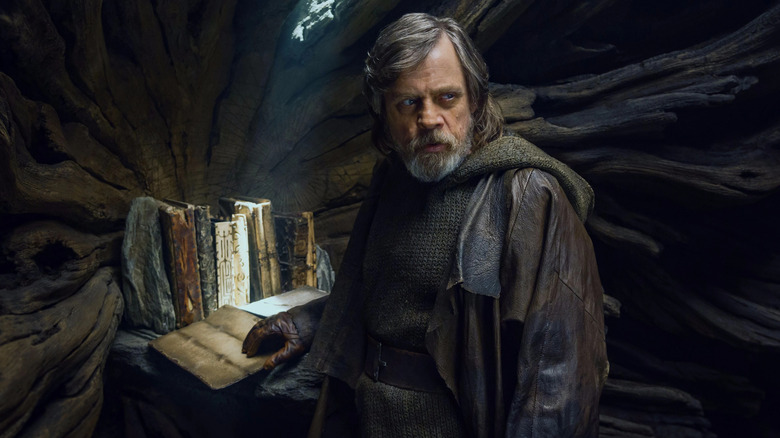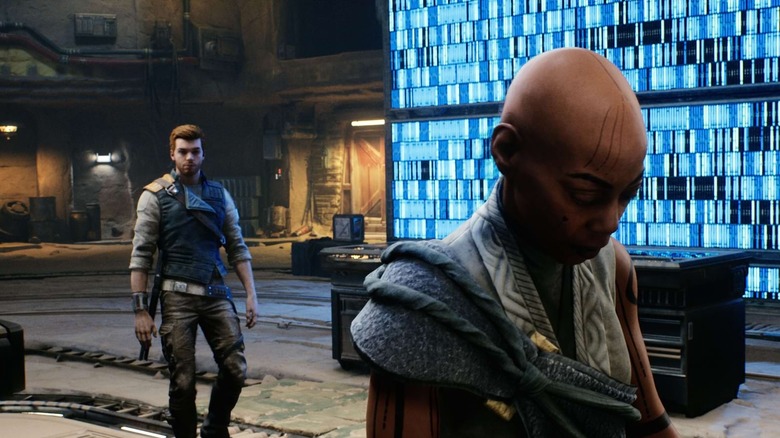Star Wars Jedi: Survivor Explains A Key Element Of The Last Jedi
The recent "Jedi" video games, "Fallen Order" and "Survivor," are the best "Star Wars" games in almost 20 years, giving us phenomenal gameplay, impressive visuals, and the best lightsaber action mechanics since "Star Wars Jedi Knight: Jedi Academy," getting us as close as we'll ever get to becoming a powerful Jedi.
The games also tell a fantastic standalone story of survival and resistance that still adds to the overall mythology of "Star Wars" in interesting ways. The games are set after the destruction of the Jedi Order and the fall of the Republic, in the Reign of the Empire era of the franchise that has been slowly but surely building up to becoming the best era of "Star Wars," as it allows for stories of rebellion featuring underdogs facing seemingly insurmountable odds.
"Jedi Survivor" picks up years after "Fallen Order," which pit Cal Kestis (Cameron Monaghan) against the Empire, Darth Vader, and Sith Inquisitors, but also saw him build a little found family of his own. The new game looks at the cost of fighting an endless fight and finds other ways of resisting. While Cal has become the most wanted man in the Empire, his former team has spread out across the galaxy, fighting in their own ways. "Jedi Survivor" may be quite standalone, with not a whole lot in terms of familiar cameos, but there is one tiny detail with huge repercussions that ties into a key element of "The Last Jedi."
Spoilers for "Jedi Survivor" to follow.
The sacred Jedi texts!
In "The Last Jedi," we reunite Luke Skywalker after he went into exile following the fall from grace of his nephew and student Ben Solo, who has turned to the dark side as Kylo Ren. When we catch up with the Jedi master, he wants nothing to do with the Force, obsessing over his failures in attempting to bring back the Jedi Order. However, Luke still holds onto one relic from his past, keeping a handful of ancient books. In fact, he gets rather panicked when he thinks they were destroyed in a fire. It is these books that hold the legacy and the teachings of the Jedi Order, the last hope of keeping their religion alive.
The movies never really show us Luke trying to rebuild the Jedi Order, save for that extremely short flashback of him training Ben Solo, though the comics and novels have him travel all around the galaxy looking for ancient sites and ancient knowledge, trying to bring back as much as he could from the Jedi. By the time of "The Last Jedi," the only things Luke has to show for it is what he calls the sacred Jedi texts, a collection of old, leather-bound books.
They don't seem like much, but just like the flash drive with the plans for the Death Star, Luke's sacred Jedi texts also have a long, long history behind them.
More than one way of fighting back
In "Jedi Survivor," Cal is reunited with his old mentor, Cere Junda, on the planet Jedha — which we see destroyed in "Rogue One." Cere has spent the past few years slowly building up a Jedi archive, like the one in the Jedi Temple on Coruscant, while also working with the Hidden Path to smuggle surviving Jedi and their allies away from Empire threat.
This is an important moment for Cal, as he realizes there is more than one way of fighting the Empire, and it doesn't have to be all about violence, even though it makes sense he'd think otherwise. After all, he was a padawan when the Clone Wars broke out, and like Ahsoka and Kanan Jarrus, Cal only knows how to be a Jedi in wartime, and using his power to fight. He knows he can't take down the Empire on his own, but he really doesn't know any other way to fight. But that's not Cere, who always dreamed of bringing back the Jedi Order. To her, rebuilding the archives, the repository of millennia of Jedi knowledge, is the true way they beat the empire.
Of course, it couldn't last. The Empire found them on Jedha and Darth Vader destroyed the archives, except for a handful of old, leather-bound books, which look exactly like the sacred Jedi texts Luke has decades later.
"Jedi Survivor," as its title implies, is all about defining resistance and surviving, about how when you lose, the small victories take bigger meaning. Most Jedi may be dead, and the archives may be destroyed, but the Jedi live on. They live in Cal, in Ahsoka, in Ezra, in Luke, and in the books that eventually pass to Rey. Even before he got thrown down an endless shaft, Palpatine had already lost.


